Acer Predator X27 Review
Acer Predator X27
True HDR, a 4K resolution and 144Hz refresh rate make this the ultimate gaming monitor.
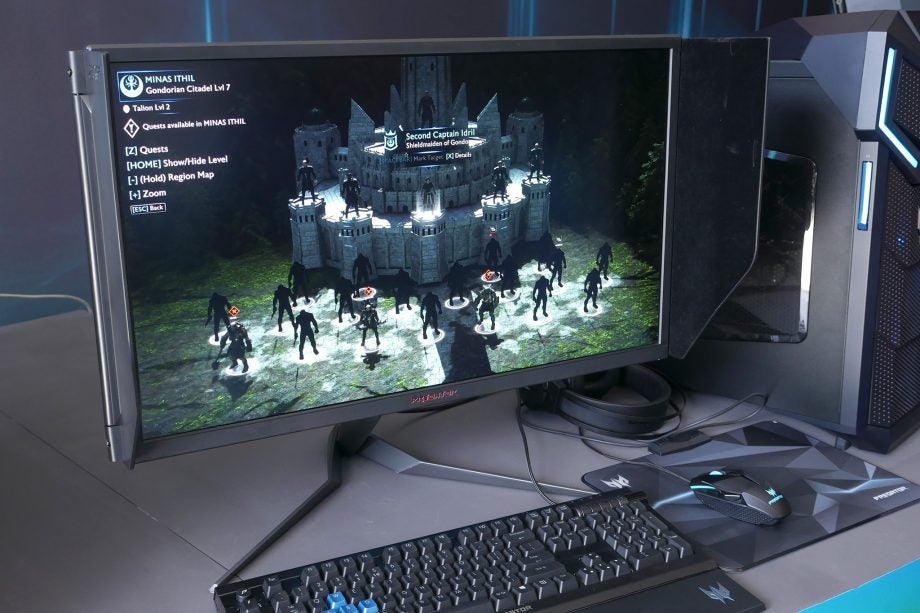
Verdict
The combination of 4K, HDR and 144Hz makes the Acer Predator X27 one of the most desirable monitors you can buy – but it's not cheap.
Pros
- Fantastic image quality
- Great gaming performance
- Stunning HDR
Cons
- Very expensive
- Still only a 27-inch display
- 4K resolution too demanding
Key Specifications
- Review Price: £2100
- 27-inch screen size
- 4K (3840 x 2160) resolution
- 144Hz refresh rate
- 4ms response time
- True HDR
- 384 zone full array local dimming backlight
- Nvidia G-Sync support
What is the Acer Predator X27?
A 144Hz refresh rate, 4K resolution and proper HDR thanks to a clever 384-zone backlight, mark the Acer Predator X27 out as one of the most feature-rich and capable gaming monitors you can buy.
Sharing an almost identical feature set to the Asus PG27UQ, these two displays reign supreme in terms of features – and are the only gaming monitors on the market to offer a true HDR experience. In turn, they demand a king’s ransom: the AcerPredator X27 costs a whopping £2100, despite it being only 27 inches across.
If you’re after the ultimate big-screen upgrade, the Acer Predator X27 isn’t for you. However, if it’s simply the finest 27-inch gaming monitor you seek then the X27 makes a strong claim for the title.
Acer Predator X27 – Design and features
The X27 is a flagship gaming monitor, and as such it displays a few flamboyant gamer-styling additions. However, as such flourishes go, they’re more subtle here than most.
Related: Best gaming monitors
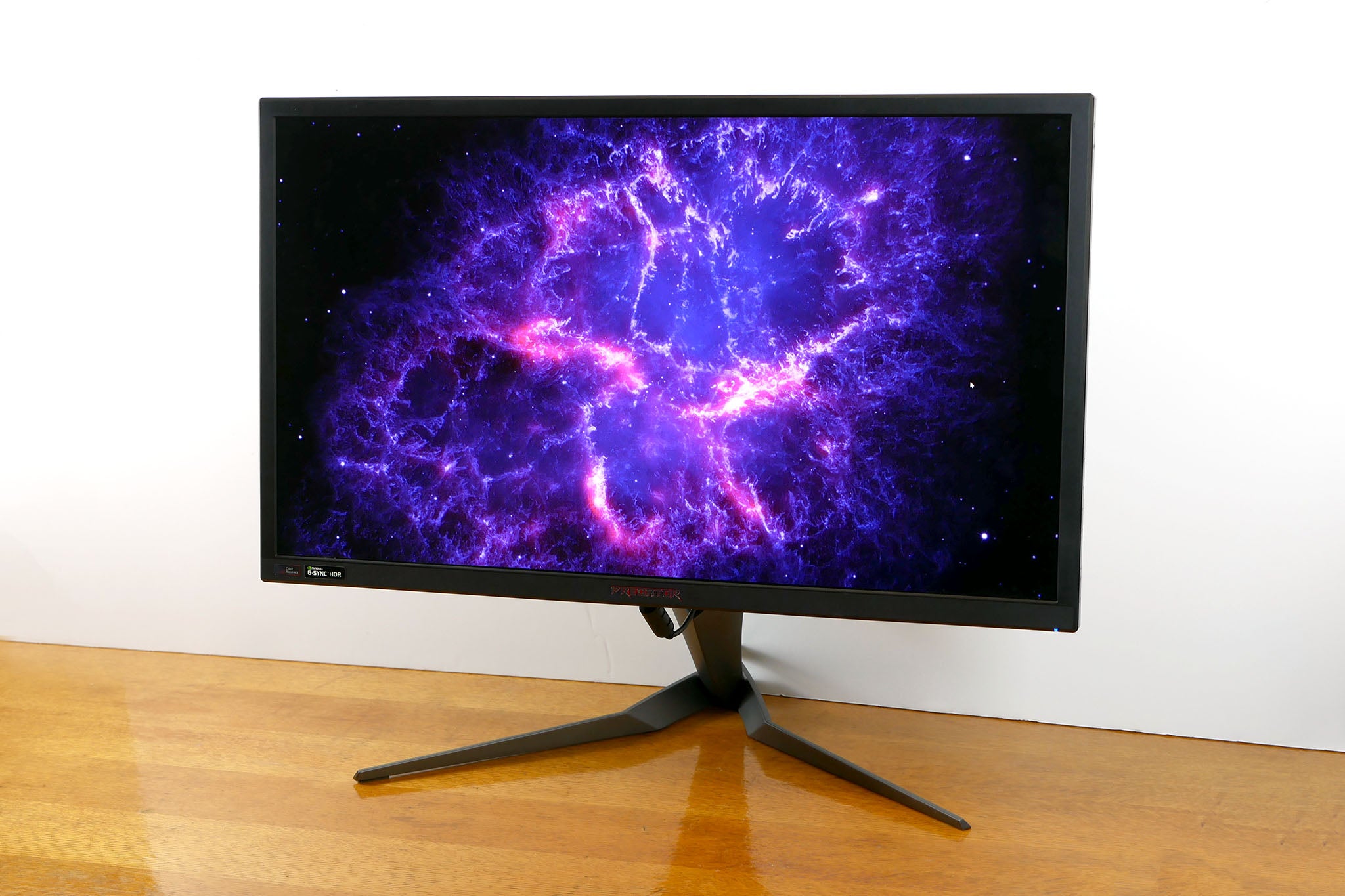
The most obvious design feature is the angular stand and base, which look fairly aggressive but keep things in check with a simple, metallic grey-paint finish. You’ll see a silver and red Predator logo on the bottom bezel, and shining from the underside of the display is a row of lights.
The latter consists of 12 LEDs that create a gentle glow onto the desk below. You can change the colour and brightness of the lights, add a breathing or flashing effect, or have the colour and brightness alter in accordance with what’s on-screen. I’d say the effects are reasonably subtle, and more likely to be used than the prominent and garish lights on the Asus PG27UQ.
Further lights can be found on the back of the display. There are several RGB LEDs embedded into one of the ventilation grilles, adding a little colour to the rear of the monitor. The light isn’t bright enough to reflect off a wall behind, so isn’t much joy when viewed from the front, although it adds a nice touch of colour when looking at the back of the display. The rear of the monitor is finished in a combination of brushed and mottled black plastic, while the front sports mottled black plastic bezels.
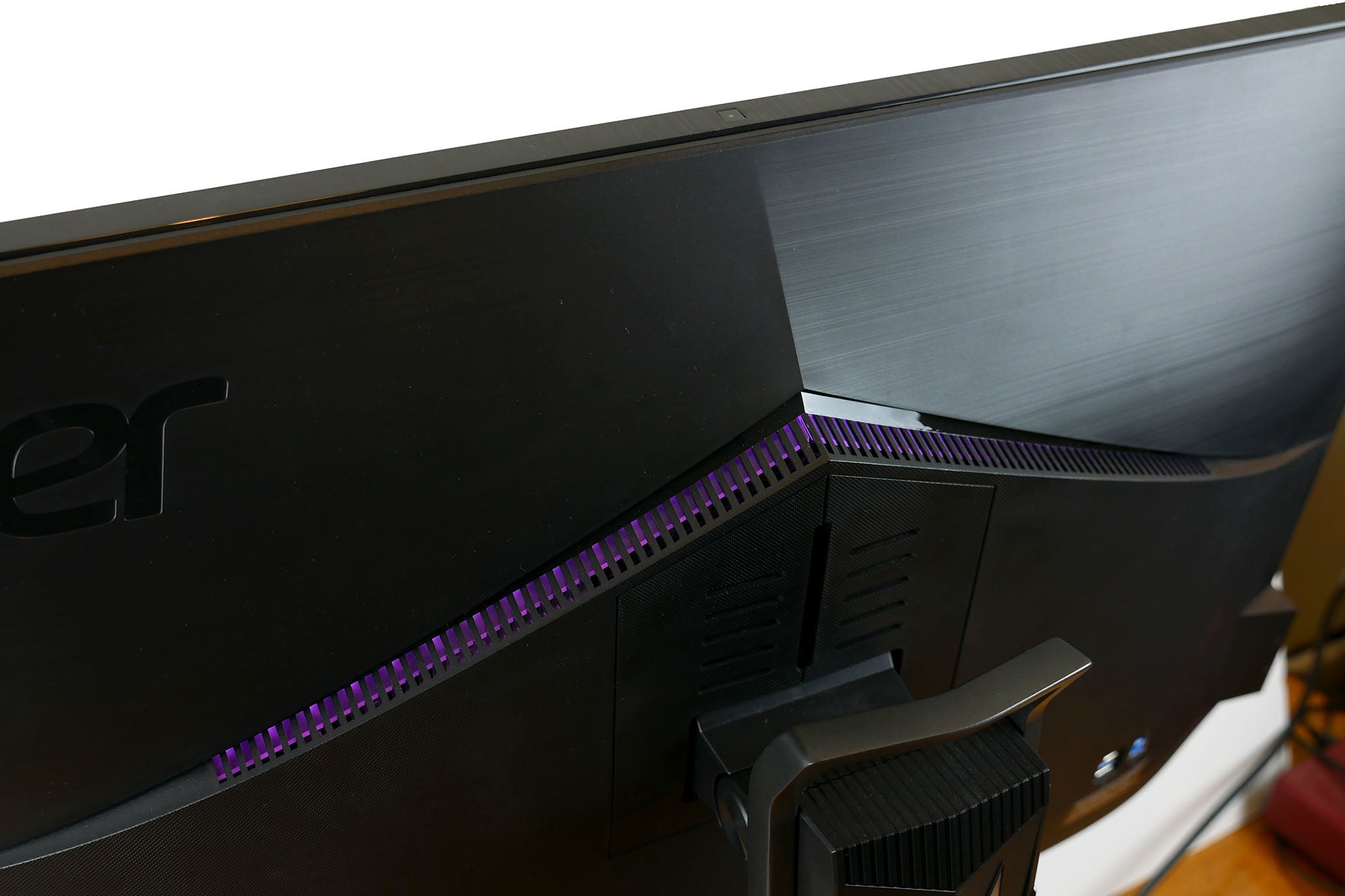
The base and main body of the stand are made from solid metal, adding a sense of quality to proceedings. It offers height, rotation and tilt adjustment, and includes a carry handle on the top too. The stand can be removed to reveal a 100 x 100mm VESA mount for use with alternative setup scenarios. However, the display can’t be pivoted into a portrait mode, which makes it difficult to reach the connections at the back.
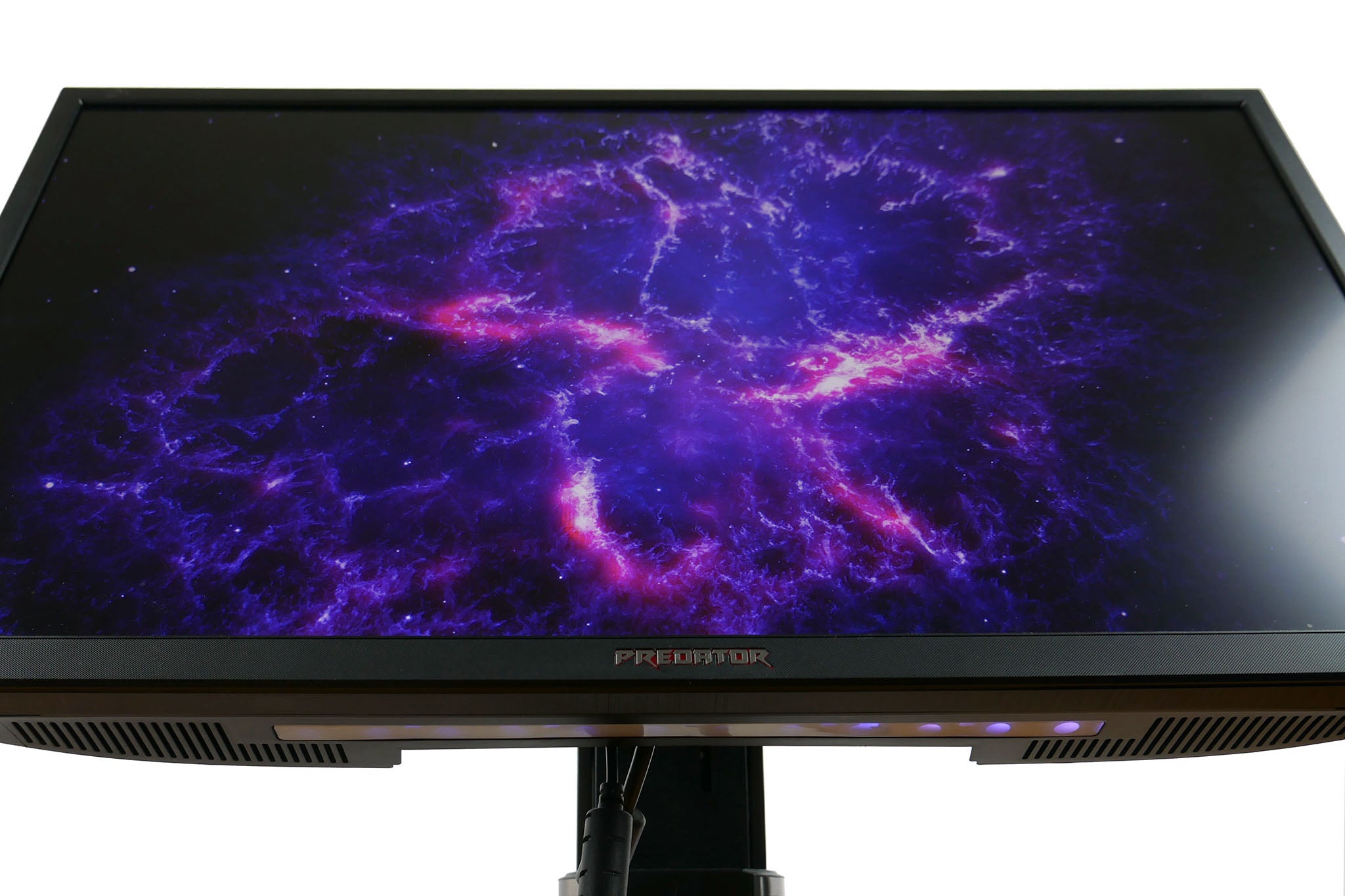
Neither does the stand rotate left and right as far as most models. It offers only 20 degrees of movement in any direction, where many others provide 30 degrees or more. Of course, you can just lift up the display and spin it round to get to the back, but weighing in at 4.77kg, it takes a fair bit of effort to do so – despite the addition of the carry handle.
The front of the X27 is missing the narrow and low-profile screen bezels more apparent on modern monitors. Here, they’re far chunkier and stand proud of the display, which results in monitor that looks far stockier than rivals.
Making good use of those thicker sides is an optional monitor shading hood. Three flock-lined plastic panels can be attached to the sides and top of the display to reduce reflections and glare from interrupting your view of the screen.
It’s the sort of addition you’d usually see on a professional-grade monitor for photographers and video editors working in bright offices – or on gaming displays meant for competition-level activity, where privacy and a lack of distraction is key. This display doesn’t really fit either of those scenarios, though it’s nice to have the option.
A light sensor can be found on the top of the display, and is used to provide an automatic brightness function. It will measure the ambient light level and change the overall brightness of the monitor accordingly.
In terms of connectivity, this display has one DisplayPort 1.4 and one HDMI 2.0 for video inputs as well as a USB 3.0 hub. The latter has two ports on the rear and two conveniently situated on the left side of the display.
On displays that don’t include Nvidia G-Sync support, you’ll often get more video inputs than this, which may be useful for if you like to have one screen serving multiple PCs, or your games consoles and set-top boxes as well as your main PC.
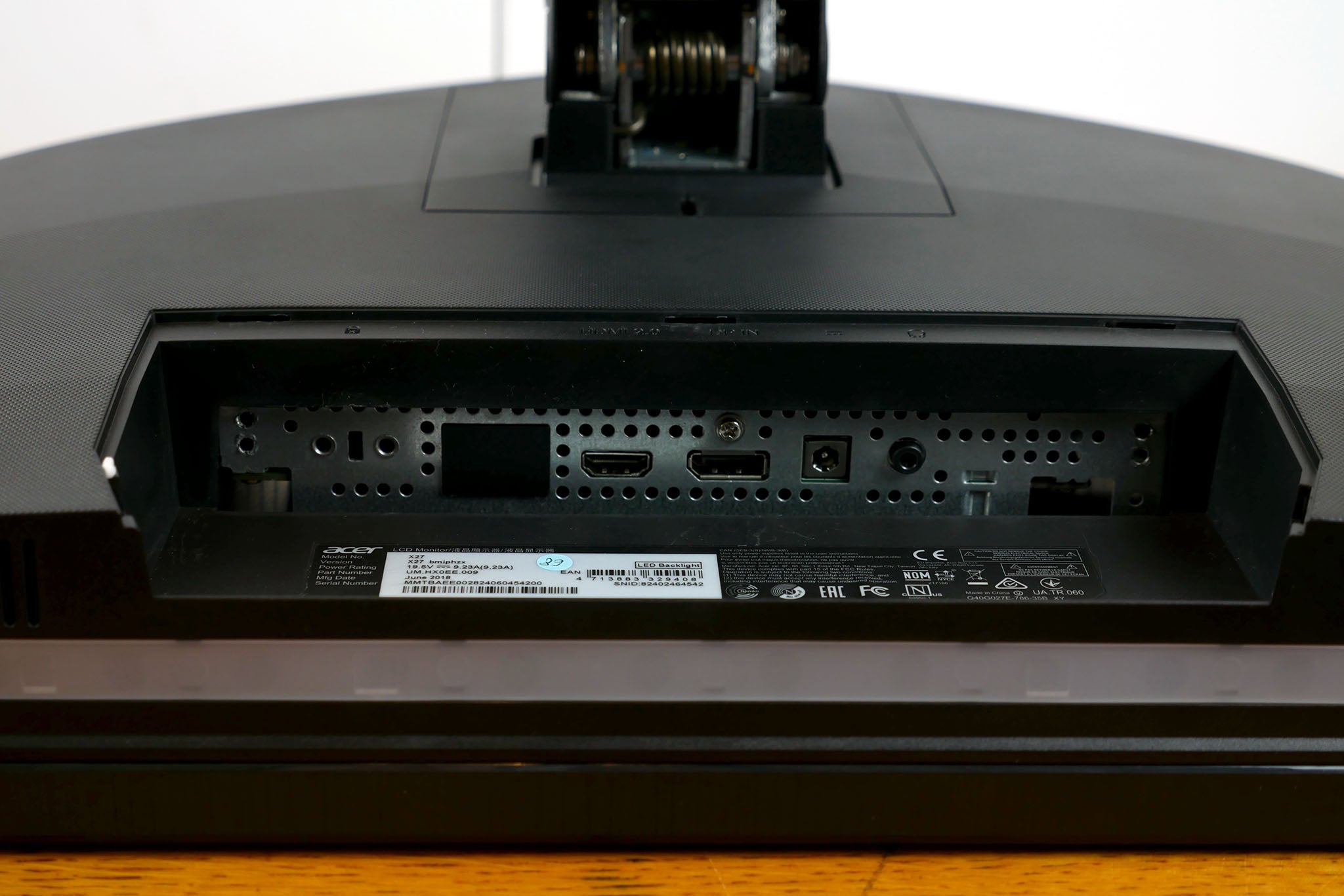
Round the back of the X27 you’ll find the controls for the on-screen display (OSD). These consist of a four-way mini-joystick and three buttons, all of which are easy to locate and nice and responsive.
As for the display itself, it has several key features to speak of. At the top of the list is its clever 384-zone backlighting system. This allows the monitor to display the very brightest colours (up to 1000 nits of brightness) right next to the darkest (down to below 0.1nits) for a theoretical contrast ratio of over 10,000:1.
That number is the key marker for true HDR, with several HDR standards requiring this level of contrast for full compliance.
The backlight can also produce a wider range of colours than conventional monitors, such that this display can also deliver the full extended colour range of true HDR content. Normal monitors use the sRGB colour space, which is equivalent to around 70% of the larger DCI-P3 colour space used for some HDR standards. HDR monitors must cover over 90% of the DCI-P3 colour space, which the X27 does.
So that’s the backlight, but there’s the LCD panel that sits in front of it. This is also special since it’s the first to provide a 4K resolution and a refresh rate higher than 60Hz. It has a native refresh rate of 120Hz and can be overclocked up to 144Hz for a smoother and more responsive gaming experience.
Acer Predator X27 – OSD and setup
The Acer X27 comes fully assembled, which means that along with the carry handle on top, it’s super0easy to get setup. In addition, you minimise the risk of damaging your new £2000 monitor while you try to attach a stand. Likewise, the adjustable stand makes it fairly easy to get all your cables plugged in, despite the lack of a pivot function.
As for the OSD, it’s as comprehensive as you’d expect for such a feature-rich monitor. Tap the joystick and it brings up the main menu, which logically comprises of six main sections: Picture, Colour (or ‘Color’ as they spell it), Audio, Gaming, OSD and System.
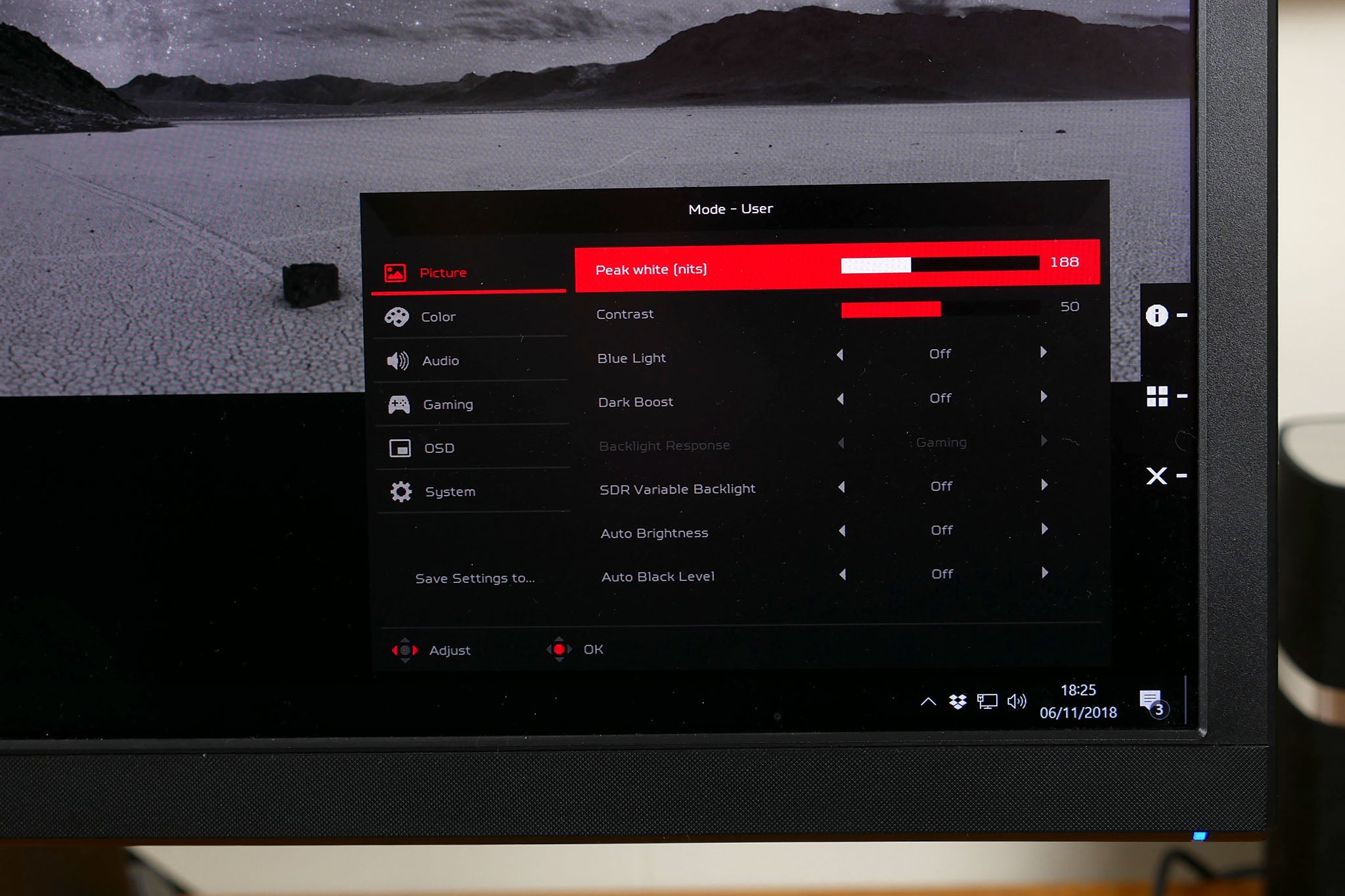
It’s in Picture that you can adjust the overall brightness setting – called Peak White – and Contrast, as well as turn on features such as Dark Boost, Auto Brightness and SDR Variable Backlight. The latter allows you to turn on the 384-zone variable backlight in order to boost the contrast of the monitor for non-HDR content, without using the extended colour range of HDR.
Jump into the Color menu and you can change the colour balance (Color Temp) and gamma, and there’s a setting called SDR Colors sRGB. Disable this and the monitor will display non-HDR colours in the Full HDR gamut. This result is colours that look oversaturated, so you’ll want to keep this setting turned on – HDR content will automatically display using the correct extended range once HDR is enabled via Windows.
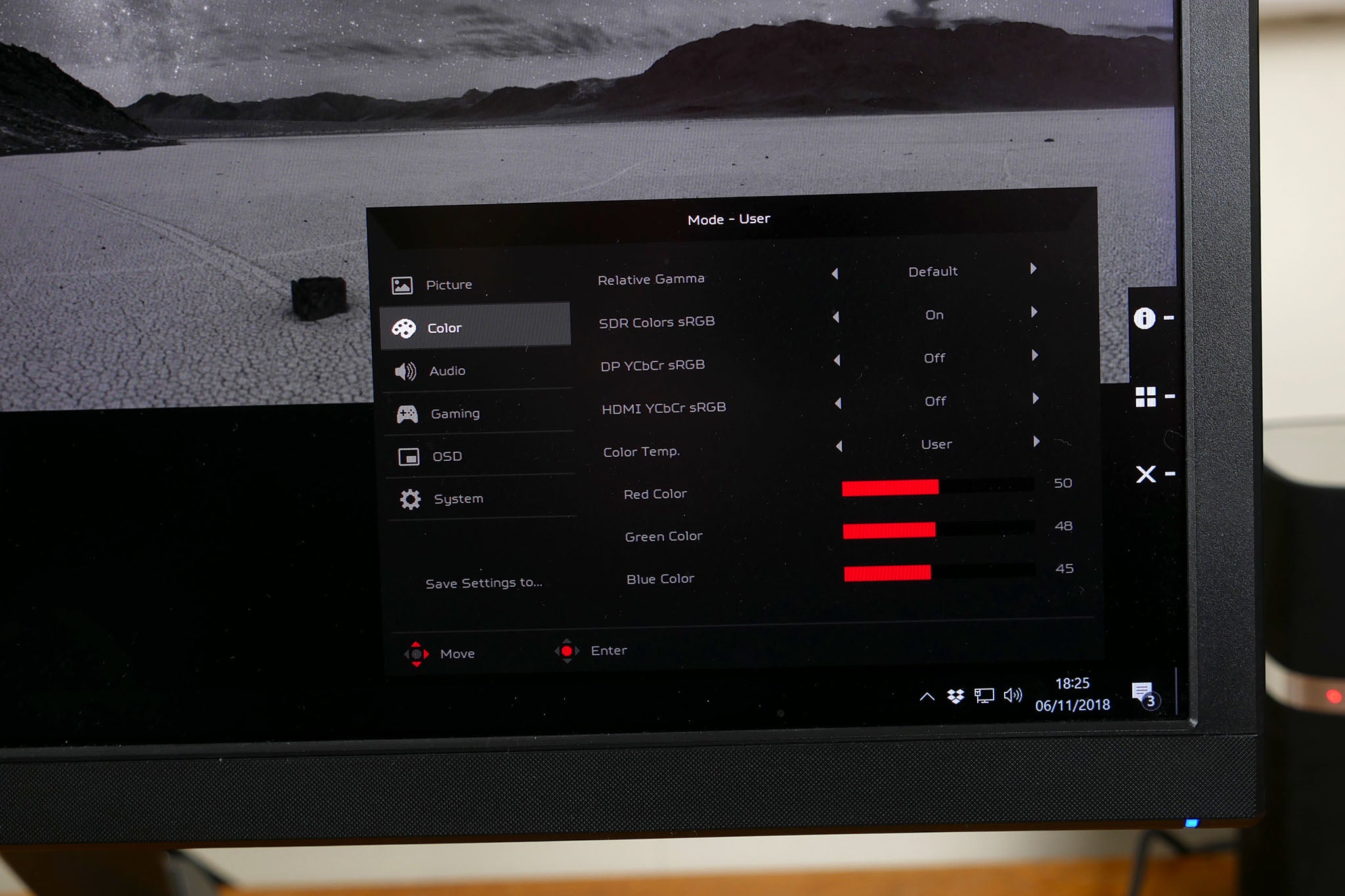
In the Gaming menu there’s the overdrive option, which offers just three settings: off, normal and extreme. “Off” produces noticeable ghosting; “extreme” results in lots of inverse ghosting; and “normal” provides a good balance, boosting sharpness without introducing too much inverse ghosting.
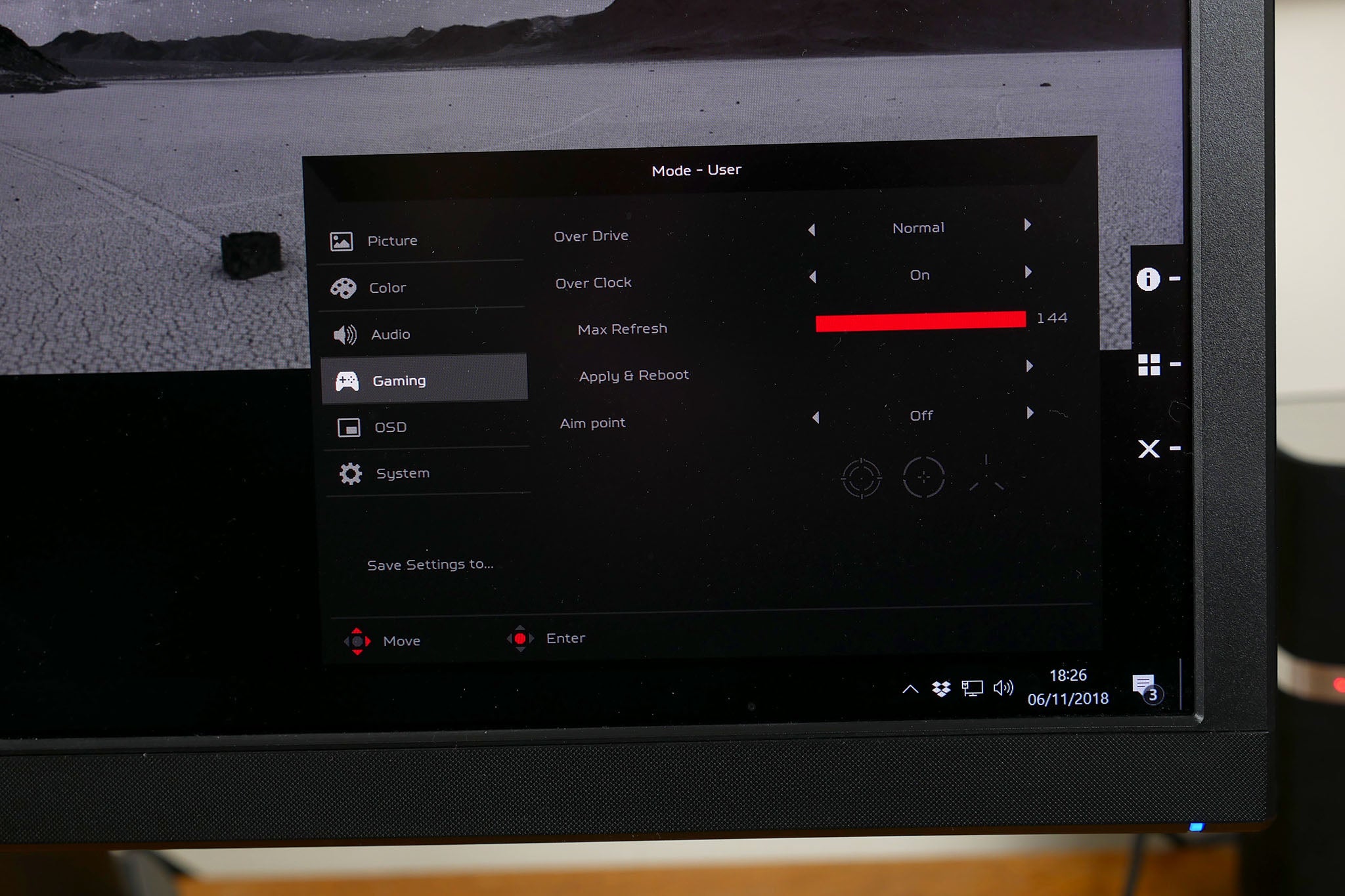
Below this is the overclocking option. The display allows you to boost the native refresh rate of 120Hz up to 144Hz. Sometimes, overclocking displays can result in a drop in image quality – but we didn’t observe any here.
The final option of note is that for the ambient light, which can be found in the System menu. You can change the brightness, colour and lighting effect, or opt for the mode that has the lights match the image on-screen.
Acer Predator X27 – Image quality
As with the Asus PG27UQ, the Acer X27 is a complex beast to assess when it comes to image quality. Fundamentally, it can operate in three different lighting modes – static, variable and HDR – plus there’s the issue of 4K to consider. We’ll start with the latter.
As a 27-inch screen, having a 4K resolution results in a pin-sharp image with a pixel density of 163 pixels per inch. This makes pictures, videos and games look amazing, and offers some benefits for general desktop use too. Alongside sharp-looking thumbnails, when editing pictures and video you can see more detail than on lower-resolution screens.
However, what you don’t get is a larger desktop area. If you use the screen at its native resolution, everything is too small to be comfortably visible. As such, you’ll have to rely on the Windows scaling option to increase the size of most items. Windows will automatically detect this and switch to the 150% scaling mode, so it’s easy to do, but it doesn’t always work as well as you’d hope.


Some things don’t scale at all, so appear super-small. Sometimes they scale up but without increasing in resolution, so everything looks blocky. Meanwhile, some older games simply don’t support 4K at all.
If you had all these slight issues, but on a screen that also offered a slightly bigger size – such as the 4K Acer XB321HK – then it would be a bit more tempting. As things stand, however, it’s a fairly even balance between the pros and cons of 4K on a screen this size.
Elsewhere, starting with the backlight set to a static mode, where the whole backlight is a uniform level of brightness, regardless of what’s on-screen, we can get a baseline sense of the image quality of this display.
Image quality – fixed backlight, SDR/8-bit
- White level: 452 nits
- Black level: 0.422
- Contrast: 1071:1
- Colour temperature: 6725K
- Gamma: 2.25
- sRGB coverage: 97.2%
- DCI-P3: 69.4%
- Delta E average: 0.34
- Delta E Max: 1.92
It can hit a whopping 452 nits maximum brightness and has a decent contrast ratio of 1071:1. For a standard display, both are decent figures. However, in terms of overall colour balance, the display isn’t quite as good as I’d hoped. Its colour temperature of 6752K is a little higher than the ideal of 6500K, and its gamma is a touch off the ideal of 2.2 as well. Neither would be deal breakers on a cheaper screen, but on such an expensive unit we’d hope for a better result.
With the help of a colorimeter and some calibration software it’s easy enough to correct both issues, however. Otherwise, with the static backlight on, this is solid image quality of the level we’d expect for a higher-quality IPS gaming screen.
The real magic, though, happens when we turn on the variable backlight. Now the contrast leaps to 4572:1, while all other aspects of the display’s image remain essentially the same. This means you can turn on this mode and get a much more dynamic, deeper-looking image that’s great for adding a bit more atmosphere when watching video and playing games.
Image quality – variable backlight, SDR
- White level: 438 nits
- Black level: 0.0958
- Contrast: 4572:1
- Colour temperature: 6769K
- Gamma: 2.24
However, the X27’s variable backlight appears to be a bit more reserved than that of the PG27UQ, with the difference in brightness of its backlight being lower than that of the Asus screen. In fact, using the default settings of our colorimeter, it only registered a contrast ratio of 2527:1 compared to over 6000:1 for the PG27UQ. We had to increase the size of the test pattern on DisplayCal to get it to show a higher contrast figure.
Finally, we come to full-blown HDR mode, where that variable backlight really comes into its own. Using a simple black and white box on a black background HDR test pattern, this screen registered a maximum brightness of 955 nits alongside a black level of 0.03 nits, for a contrast ratio of 31,833:1.
Engaging HDR mode in Windows also opens up the display’s wider colour range, allowing for up to 92.7% DCI-P3 colour space coverage – comfortably above the 90% required by some HDR standards.
Image quality – HDR
- White level: 955 nits
- Black level: 0.03 nits
- Contrast: 31,833:1
- sRGB coverage: 100%
- DCI-P3: 92.7%
This extra range results in colours that simply have more zing to them. The most striking example tends to be video of green grass and other foliage on a bright sunny day – it’s so much more dazzling than standard dynamic range video.
Fire up some good-quality 4K HDR video, or play a game that supports HDR at 4K resolution, and this display comes to life. There’s nothing else quite like it, other than the PG27UQ.
The only problem being that there aren’t all that many games or videos out there that support HDR. The list is growing but, in a similar way to 3D, it’s something that tends to be reserved only for blockbuster releases, and that doesn’t look set to change any time soon.
Acer Predator X27 – Gaming
We’ve touched on the great HDR gaming experience, but the other key aspect to this screen is its 144Hz refresh rate. This combines with a 4ms response time to deliver performance that’s a nice step up from any previous 4K screen.
However, the overall responsiveness here isn’t quite as good as other 27-inch, 144Hz IPS screens such as Acer’s own XB271HU. The difference is subtle, but for that competitive edge we’d stick with the latter.
Then again, this screen was never really meant to be about offering up the ultimate in gaming performance. It’s more than adequate for single-player gaming and can hold its own in more casual competitive scenarios. If you’re really looking to push performance then image quality goes out of the window; in this case you should opt for a 1ms TN monitor.
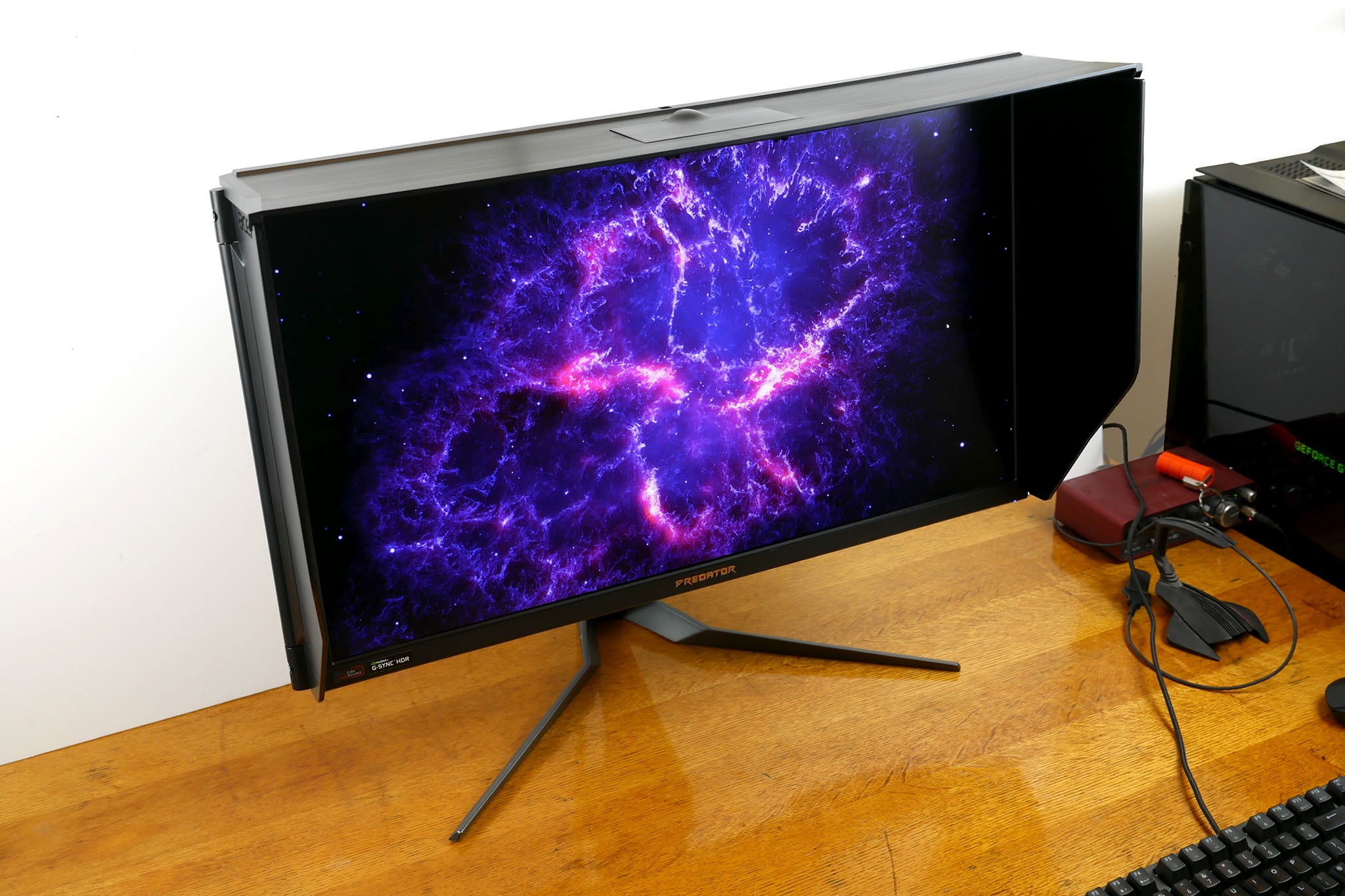
Why buy the Acer Predator X27?
The Acer X27 is a seriously impressive monitor. Its HDR performance is better than any other so-called HDR monitor – other than the Asus PG27UQ – and when combined with its 4K resolution, it delivers stunning image quality. It’s quite mesmerising at times.
The 120Hz/144Hz refresh rate also makes it a reasonably capable gaming screen, even if it doesn’t push the absolute limits of screen performance.
If you’re after the ultimate 27-inch monitor, this could certainly make a strong claim for the title.
However, for many the size of the screen will be an issue, considering its price. If you’ve already upgraded from a 27-inch screen to a 32-inch or 34-inch ultra-wide unit then going back to 27-inch will feel like a downgrade.
The 4K resolution is also as much a hindrance as a help in many situations, and the lack of HDR content means the flagship feature of this screen is only of so much use.
Verdict
It isn’t without issues but the Acer X27’s combination of 4K, HDR and 144Hz makes it one of the most desirable monitors you can buy – despite its high price.

